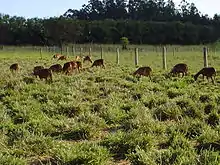 | |
| Other names |
|
|---|---|
| Country of origin | Brazil |
| Distribution | Nordeste |
| Use | dual-purpose, meat and hide[1]: 16 |
| Traits | |
| Weight | |
| Height | |
| Wool color | solid colour, red or white |
| Horn status | Ewes hornless, rams may have scurs |
| |
Morada Nova is a Brazilian breed of domestic sheep. It originates in the state of Ceará, in Nordeste, the north-eastern region of Brazil, on the Atlantic coast.[3][4]
Characteristics
Use
The Morada Nova is well adapted to the varied climatic conditions of the sertão, and well able to forage in the caatinga scrub biome of the area.[2][5]: 3352 It is reared principally for meat.[2] Animals are slaughtered when they are between 18 and 24 months old, when they weigh 27–35 kg. Males are not usually castrated.[6] The hides are of good quality.[1]: 34 Ewes are not milked, and the sheep are not shorn.[6]
References
- 1 2 Arthur da Silva Mariante, Concepta McManus, José Francisco Mendonça (editors) (2003). Country report on the state of animal genetic resources: Brazil. Brasília : Embrapa Genetic Resources and Biotechnology, ISSN 0102-0110; annex to The State of the World's Animal Genetic Resources for Food and Agriculture. Rome: Food and Agriculture Organization of the United Nations. ISBN 9789251057629. Accessed January 2017.
- 1 2 3 4 5 6 Breed data sheet: Morada Nova/Brazil. Domestic Animal Diversity Information System of the Food and Agriculture Organization of the United Nations. Accessed January 2017.
- ↑ Valerie Porter, Lawrence Alderson, Stephen J.G. Hall, D. Phillip Sponenberg (2016). Mason's World Encyclopedia of Livestock Breeds and Breeding (sixth edition). Wallingford: CABI. ISBN 9781780647944.
- ↑ Barbara Rischkowsky, D. Pilling (eds.) (2007). List of breeds documented in the Global Databank for Animal Genetic Resources, annex to The State of the World's Animal Genetic Resources for Food and Agriculture. Rome: Food and Agriculture Organization of the United Nations. ISBN 9789251057629. Accessed January 2017.
- ↑ M.H. Rajab, T.C. Cartwright, P.F. Dahm, E.A.P. Figueiredo (1992). Performance of three tropical hair sheep breeds. Journal of Animal Science 70: 3351–3359. doi:10.2527/1992.70113351x
- 1 2 E.A.P. Figueiredo (1980). Morada Nova of Brazil. In: I.L. Mason (1980). Prolific Tropical Sheep. Rome: Food and Agriculture Organization of the United Nations. ISBN 9251008450.
This article is issued from Wikipedia. The text is licensed under Creative Commons - Attribution - Sharealike. Additional terms may apply for the media files.